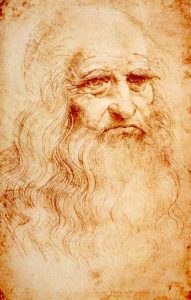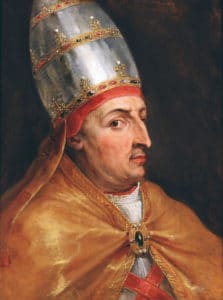
Following the conclusion of the western schism in favor of Rome at the Council of Constance (1415–1417), the new Pope Martin V returned to the Papal States after a three years-long journey that touched many Italian cities and restored Italy as the sole center of Western Christianity. During the course of this voyage, the Medici Bank was made the official credit institution of the Papacy and several significant ties were established between the Church and the new political dynasties of the peninsula. The Popes’ status as elective monarchs turned the conclaves and consistories of the Renaissance into political battles between the courts of Italy for primacy in the peninsula and access to the immense resources of the Catholic Church. In 1439, Pope Eugenius IV and the Byzantine Emperor John VIII Palaiologos signed a reconciliation agreement between the Catholic Church and the Orthodox Church at the Council of Florence hosted by Cosimo the old de Medici. In 1453, Italian forces under Giovanni Giustiniani were sent by Pope Nicholas V to defend the Walls of Constantinople but the decisive battle was lost to the more advanced Turkish army equipped with cannons, and Byzantium fell to Sultan Mehmed II.

The fall of Constantinople led to the migration of Greek scholars and texts to Italy, fueling the rediscovery of Greco-Roman Humanism. Humanist rulers such as Federico da Montefeltro and Pope Pius II worked to establish ideal cities where man is the measure of all things, and therefore founded Urbino and Pienza respectively. Pico della Mirandola wrote the Oration on the Dignity of Man, considered the manifesto of Renaissance Humanism, in which he stressed the importance of free will in human beings. The humanist historian Leonardo Bruni was the first to divide human history in three periods: Antiquity, Middle Ages and Modernity. The second consequence of the Fall of Constantinople was the beginning of the Age of Discovery.
Italian explorers and navigators from the dominant maritime republics, eager to find an alternative route to the Indies in order to bypass the Ottoman Empire, offered their services to monarchs of Atlantic countries and played a key role in ushering the Age of Discovery and the European colonization of the Americas. The most notable among them were: Christopher Columbus, colonizer in the name of Spain, who is credited with discovering the New World and the opening of the Americas for conquest and settlement by Europeans; John Cabot, sailing for England, who was the first European to set foot in “New Found Land” and explore parts of the North American continent in 1497; Amerigo Vespucci, sailing for Portugal, who first demonstrated in about 1501 that the New World (in particular Brazil) was not Asia as initially conjectured, but a fourth continent previously unknown to people of the Old World (America is named after him); and Giovanni da Verrazzano, at the service of France, renowned as the first European to explore the Atlantic coast of North America between Florida and New Brunswick in 1524.
